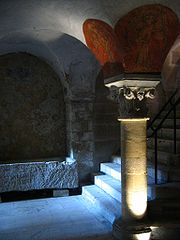- Crypt
-
This article is about the stone chambers called "crypts". For other uses, see Crypt (disambiguation).Crypt of Bayeux Cathedral, France

In architecture, a crypt (from the Latin crypta and the Greek κρύπτη, kryptē; meaning concealed, private) is a stone chamber or vault beneath the floor of a burial vault possibly containing sarcophagi, coffins or relics.
Originally crypts were typically found below the main apse of a church, such as at the Abbey of Saint-Germain en Auxerre, but were later located beneath naves and transepts as well. Occasionally churches were raised high to accommodate a crypt at the ground level, such as St Michael's Church in Hildesheim, Germany.
Contents
Development
First known in the early Christian period, in particular North Africa at Chlef and Djemila in Algeria, and Byzantium at Saint John Studio in Constantinople. Where Christian churches have been built over mithraea, the mithraeum has often been adapted to serve as a crypt.[citation needed]
The famous crypt at Old St. Peter's Basilica, Rome, developed about the year 600, as a means of affording pilgrims a view of Saint Peter's tomb, which lay, according to the Roman fashion, directly below the high altar. The tomb was made accessible through an underground passageway beneath the sanctuary, where pilgrims could enter at one stair, pass by the tomb and exit, without interrupting the clerical community's service at the altar directly above.[1]
Crypts were introduced into Frankish church building in the mid-eighth century, as a feature of its Romanization. Their popularity then spread more widely in western Europe under Charlemagne. Examples from this period are most common in the early medieval West, for example in Burgundy at Dijon and Tournus.
After the 10th century the early medieval requirements of a crypt faded, as church officials permitted relics to be held in the main level of the church. By the Gothic period crypts were rarely built, however burial vaults continued to be constructed beneath churches and referred to as crypts.
Burial vaults
Main article: Burial vault (tomb)In more modern terms, a crypt is most often a stone chambered burial vault used to store the deceased. Crypts are usually found in cemeteries and under public religious buildings, such as churches or cathedrals, but are also occasionally found beneath mausolea or chapels on personal estates. Wealthy or prestigious families will often have a 'family crypt' or 'vault' in which all members of the family are interred. Many royal families, for example, have vast crypts containing the bodies of dozens of former royals. In some localities an above ground crypt is more commonly called a mausoleum, which also refers to any elaborate building intended as a burial place, for one or any number of people.
There was a trend in the 1800s of building crypts on medium to large size family estates, usually subtly placed on the edge of the grounds or more commonly incorporated into the cellar. After a change of owner these are often blocked up and the house deeds will not allow this area to be re-developed.[citation needed]
Gallery
-
Crypt Saint-Sernin Basilica Toulouse
-
Crypt of Worcester Cathedral
-
Crypt in Wola Gułowska, Poland
-
Inside the crypt of St Eusebius' Church, Arnhem
-
Wasserkirche church Zürich with so called 'Martyr stone' (Felix and Regula)
-
Grossmünster church crypt with Charlemagne statue
-
Katholische Hofkirche cathedral in Dresden, Wettin crypt with Requiem altar.
Notes
- ^ Apollonj Ghetti, et al. eds. Esplorazioni sotto la confessione di San Pietro. Eseguite negli anni 1940-1949 (Città del Vaticano, 1951) 1:173-93, noted in Werner Jacobsen, "Saints' Tombs in Frankish Church Architecture" Speculum 72.4 (October 1997:1107-1143) p. 1134 note 70.
See also
Categories:- Burial monuments and structures
-
Wikimedia Foundation. 2010.








